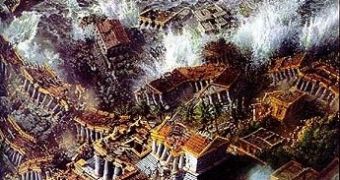Any myth bears a grain of truth and is not just about some stories invented by the human mind. This is also the case of Atlantis, the country swallowed by the sea. The myth of Atlantis, the city state engulfed by the sea waters, was first mentioned by Plato 2400 years ago and has been firing the popular imagination for centuries. In reality, the legend talks about a real ancient civilization swallowed by the sea. Indeed, the Atlantic Ocean received its name from Atlantis, as fantasist imaginations placed its location in the middle of this ocean. But increasing evidence shows that this civilization could have been located in the Crete Island and matched with the pre-Greek Minoan civilization.
3,500 years ago, Minoans developed a sophisticated civilization in the islands of the Eastern Mediterranean, while the rest of the Europe was still in the Neolithic phase. There were building palaces, paved streets and sewers. Most Europeans, including later Greeks, were migratory tribes living in primitive shelters. These pre-Greek populations could have been not even Indo-European, but rather related to the Basque or Caucasus ethnic groups.
But around 1500 BC the people who created the myths of the Minotaur and the Labyrinth suddenly vanished, as a result of a giant tsunami or so it seems. Researchers have discovered new proofs that Crete experienced a massive tsunami by the time of Minoan disappearance.
"The geo-archaeological deposits contain a number of distinct tsunami signatures," said geologist Professor Hendrik Bruins of the Ben-Gurion University of the Negev in Israel.
"Minoan building material, pottery and cups along with food residue such as isolated animal bones were mixed up with rounded beach pebbles and sea shells and microscopic marine fauna. The latter can only have been scooped up from the sea-bed by one mechanism - a powerful tsunami, dumping all these materials together in a destructive swoop," Bruins added.
The layers were detected up to 7 m (23 ft) above the sea level, much higher than the normal reach of storm waves. "An event of ferocious force hit the coast of Crete and this wasn't just a Mediterranean storm," said Bruins.
The Minoan civilization was of sailors and traders. Their towns were located mostly on the coast, exposing them to tsunami.
On Palaikastro (Eastern Crete), Canadian archaeologist Sandy MacGillivray has been excavating for 25 years in one of the largest Minoan cities. He detected here another matching situation: buildings with walls facing the sea were missing, but side walls, not exposed to giant waves, were left intact.
"All of a sudden a lot of the deposits began making sense to us. Even though the town of Palaikastro is a port it stretched hundreds of meters into the hinterland and is, in places, at least 15 meters above sea level. This was a big wave." said MacGillivary.
One issue has impeded the researchers to see clearly the case of Atlantis.
"The study of ancient tsunamis is in its infancy and people have not, until now, really known what to look for." said tsunami expert Costas Synolakis, from the University of Southern California.
Researchers had not known what kind of deposits a tsunami leaves behind it till the devastating Asian tsunami of 2004. "If you remember the video footage, some of it showed tones of debris being carried along by the wave and much of it was deposited inland." said Synolakis.
The ancient wave could have been as powerful as the one of the Asian tsunami that killed 250,000 people.
"The Minoans are so confident in their navy that they're living in unprotected cities all along the coastline. Now, you go to Banda Aceh [in Indonesia] and you find that the mortality rate is 80%. If we're looking at a similar mortality rate, that's the end of the Minoans." said MacGillivary.
Regarding the cause of the ancient tsunami, all data point to the huge eruption of the Santorini volcano, 70 km north of Crete, which matched the data of the sudden Minoan decline.The Santorini eruption was up to 10 times more powerful than the Krakatoa blast in 1883, and volcanic stones reached even the Egyptian shore of the Sinai peninsula while it was heard at more than 3,000 miles (4,800 km) away. The falling of Santorini's huge cone into the sea during the blast must have produced the big wave. In fact, many land masses from the Aegean Sea could have sunk with the eruption (was the Atlantis city located in one of them?).
Probably the wave did not reach Knossos, the inland Minoan capital, but the massive ash falls could have ruined the crop, inducing famine and disaster in a population trapped on the Island by its destroyed navy. At the same time, Egyptian documents mention a massive invasion of the "People of the Sea", seafaring raiders that probably fled famine from the Crete Island. In Canaan, they mixed with local Hebrew people and gave birth to another civilization of seafarers, the Phoenicians.

 14 DAY TRIAL //
14 DAY TRIAL //